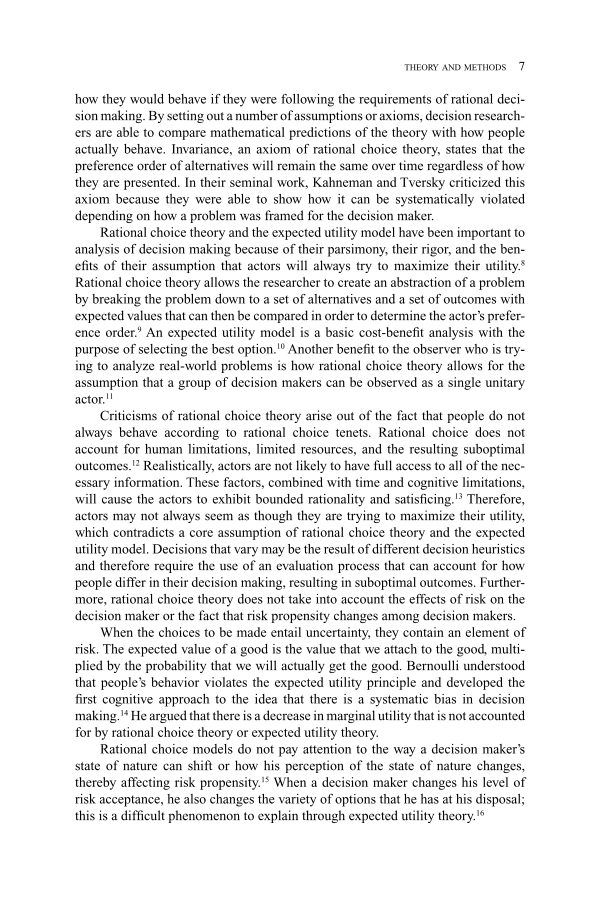THEORY AND METHODS 7 how they would behave if they were following the requirements of rational deci- sion making. By setting out a number of assumptions or axioms, decision research- ers are able to compare mathematical predictions of the theory with how people actually behave. Invariance, an axiom of rational choice theory, states that the preference order of alternatives will remain the same over time regardless of how they are presented. In their seminal work, Kahneman and Tversky criticized this axiom because they were able to show how it can be systematically violated depending on how a problem was framed for the decision maker. Rational choice theory and the expected utility model have been important to analysis of decision making because of their parsimony, their rigor, and the ben- efi ts of their assumption that actors will always try to maximize their utility. 8 Rational choice theory allows the researcher to create an abstraction of a problem by breaking the problem down to a set of alternatives and a set of outcomes with expected values that can then be compared in order to determine the actor’s prefer- ence order. 9 An expected utility model is a basic cost-benefi t analysis with the purpose of selecting the best option. 10 Another benefi t to the observer who is try- ing to analyze real-world problems is how rational choice theory allows for the assumption that a group of decision makers can be observed as a single unitary actor. 11 Criticisms of rational choice theory arise out of the fact that people do not always behave according to rational choice tenets. Rational choice does not account for human limitations, limited resources, and the resulting suboptimal outcomes. 12 Realistically, actors are not likely to have full access to all of the nec- essary information. These factors, combined with time and cognitive limitations, will cause the actors to exhibit bounded rationality and satisfi cing. 13 Therefore, actors may not always seem as though they are trying to maximize their utility, which contradicts a core assumption of rational choice theory and the expected utility model. Decisions that vary may be the result of different decision heuristics and therefore require the use of an evaluation process that can account for how people differ in their decision making, resulting in suboptimal outcomes. Further- more, rational choice theory does not take into account the effects of risk on the decision maker or the fact that risk propensity changes among decision makers. When the choices to be made entail uncertainty, they contain an element of risk. The expected value of a good is the value that we attach to the good, multi- plied by the probability that we will actually get the good. Bernoulli understood that people’s behavior violates the expected utility principle and developed the fi rst cognitive approach to the idea that there is a systematic bias in decision making. 14 He argued that there is a decrease in marginal utility that is not accounted for by rational choice theory or expected utility theory. Rational choice models do not pay attention to the way a decision maker’s state of nature can shift or how his perception of the state of nature changes, thereby affecting risk propensity. 15 When a decision maker changes his level of risk acceptance, he also changes the variety of options that he has at his disposal this is a diffi cult phenomenon to explain through expected utility theory. 16
Document Details My Account Print multiple pages
Print
You have printed 0 times in the last 24 hours.
Your print count will reset on at .
You may print 0 more time(s) before then.
You may print a maximum of 0 pages at a time.

























































































































































